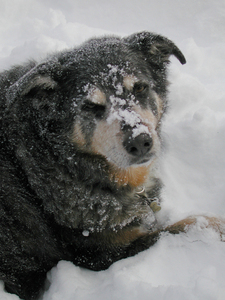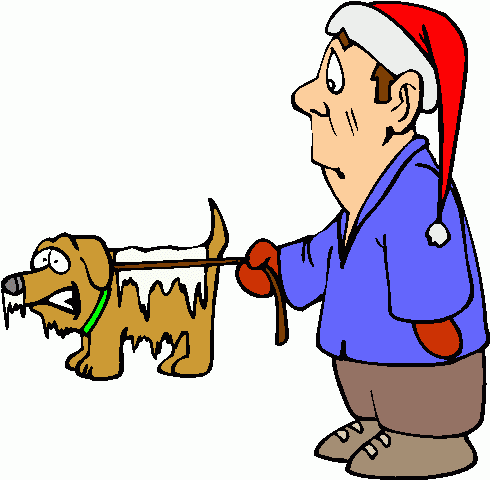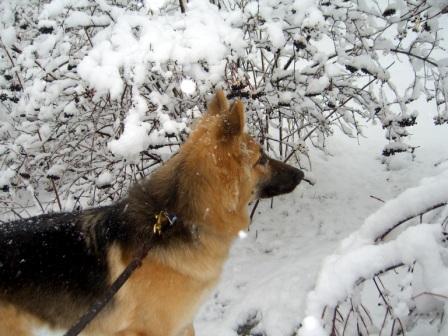Winter Pet Precautions
By Trish Phillips
For many pet owners, winter means staying at home (and inside) as much as possible. Just as we need time to acclimate, our pets do as well. But remember, the cold weather doesn’t have to mean hibernation – there are many fun things to do with your pets this time of year.
There are some simple things you can do to keep your pet warm and safe this winter:
Preparation
If you haven’t already, have your furnace checked for carbon monoxide leaks. Pets are more vulnerable to carbon monoxide poisoning than the rest of the family – because they spend more time at home and because they are smaller in size.
Take your pet for a check-up with their vet to ensure there are not any underlying medical issues that will make them more vulnerable to the cold.
 In General
In General
Winter weather can make elderly and arthritic pets extremely stiff and tender – both indoors and out. Walk behind (and below) them on stairs. Walk slowly outside to avoid slips and falls.
Pets lose most of their body heat from the pads of their feet, their ears and their respiratory tract. The sweater will help a little, but won’t completely protect your pet from the cold.
To keep your pet’s pads from getting chapped and raw, wipe any salt, ice or chemical ice melts from their feet as soon as they come inside. If they will tolerate them, there are special booties that can help protect their paws while they are outside. Some people prefer to use a balm on their pads to protect from the elements.
Outdoors
Stay outside with your pets. When you feel you need to go inside, they probably do, too. If left alone outside, occasionally pets get trapped looking for warm shelter – digging into snow banks, hiding under porches or window wells.
If you live near a pond or lake, make sure your dog is on leash or you are with them at all times so that they do not accidentally fall through the ice.
Cats like to curl up to almost anything to stay warm – including car engines. Before starting your car, check beneath, rap on the hood or honk your horn.
 When you are outside with your pets, watch for signs of discomfort – whining, shivering, anxiety, holding up their feet, slowing down or stopping – these signify that they want to get someplace warm. Be prepared to check feet for ice and snow balls that form between the pads of the feet. Clean feet with clean, lukewarm water upon arriving home.
When you are outside with your pets, watch for signs of discomfort – whining, shivering, anxiety, holding up their feet, slowing down or stopping – these signify that they want to get someplace warm. Be prepared to check feet for ice and snow balls that form between the pads of the feet. Clean feet with clean, lukewarm water upon arriving home.
If you must keep your pet outside, make sure they have warm, solid (preferably insulated) shelter that blocks the wind and a thick layer of hay or dry bedding (check bedding regularly to make sure it’s dry) that they can snuggle into. Be sure they have plenty of non-frozen water so that they don’t look to puddles or gutters that might also have oil, antifreeze or chemicals present. You might consider getting a heated pad or water bowl for your pet if they must stay outside in the winter. (if it’s below zero bring them into a safe, warmer shelter (barn, garage, basement or house)
Indoors
Fireplaces and space heaters are attractive to your pet as they are to you. Watch to make sure that their tails and paws do not come in to contact with hot surfaces. Also, secure the heat sources so that they cannot be knocked over.
Also, be mindful of two serious conditions caused by cold weather: frostbite and hypothermia. Frostbite is less common and happens when the body gets cold and pulls blood from the extremities to the center of the body to stay warm. Hypothermia, or below-normal body temperature, is a condition that occurs when the animal is not able to keep its body temperature at the normal level.
 Frostbite is tricky because it is not immediately obvious – tissue doesn’t show signs of damage for several days. The animal’s ears, paws or tail can get cold enough that ice crystals form within the tissue and cause damage. If you suspect that your pet has frostbite, bring it into a warm environment right away. Soak the extremities in tepid (not hot) water for 20 minutes to melt the ice crystals and restore circulation. It is important that you do not rub frostbitten tissue – the ice crystals can do a lot of damage to the tissue. Once your pet is warm, wrap it in some blankets and take it to your veterinarian. They can assess the damage and treat your pet for pain or infection if necessary.
Frostbite is tricky because it is not immediately obvious – tissue doesn’t show signs of damage for several days. The animal’s ears, paws or tail can get cold enough that ice crystals form within the tissue and cause damage. If you suspect that your pet has frostbite, bring it into a warm environment right away. Soak the extremities in tepid (not hot) water for 20 minutes to melt the ice crystals and restore circulation. It is important that you do not rub frostbitten tissue – the ice crystals can do a lot of damage to the tissue. Once your pet is warm, wrap it in some blankets and take it to your veterinarian. They can assess the damage and treat your pet for pain or infection if necessary.
Hypothermia happens when animals spend too much time in cold temperatures, or when animals with poor health or circulation are exposed to cold. In mild cases, animals will shiver and show signs of depression, lethargy, and weakness. As the condition progresses, an animal’s muscles will stiffen, her heart and breathing rates will slow down, and she will stop responding to stimuli.
If you notice these symptoms, you need to get your pet warm and take her to your veterinarian. You can wrap her in blankets, possibly with a hot water bottle or an electric blanket. As always, remember to wrap hot items in fabric to prevent against burning the skin. In severe cases, your veterinarian can monitor her heart rate and blood pressure and give warm fluids through an IV.
With a little preparation and awareness, winter can be fun for both us and our pets.

